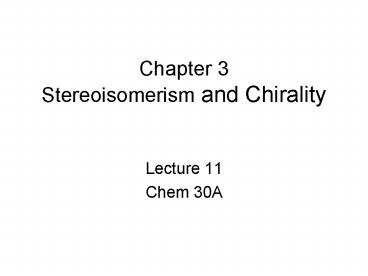Chapter 3 Stereoisomerism and Chirality - PowerPoint PPT Presentation
1 / 19
Title:
Chapter 3 Stereoisomerism and Chirality
Description:
Chapter 3. Stereoisomerism and Chirality. Lecture 11. Chem 30A. Enantiomers & Diastereomers ... Chirality in the Biological World ... – PowerPoint PPT presentation
Number of Views:635
Avg rating:3.0/5.0
Title: Chapter 3 Stereoisomerism and Chirality
1
Chapter 3Stereoisomerism and Chirality
- Lecture 11
- Chem 30A
2
Enantiomers Diastereomers
- 2-Methylcyclopentanol
3
Enantiomers Diastereomers
- 1,2-Cyclopentanediol
4
Enantiomers Diastereomers
- cis-3-Methylcyclohexanol (pair of enantiomers)
5
Enantiomers Diastereomers
- trans-3-Methylcyclohexanol (pair of enantiomers)
6
Isomers
7
Properties of Stereoisomers
- Enantiomers have identical physical and chemical
properties in achiral environments. - Diastereomers are different compounds and have
different physical and chemical properties. - meso tartaric acid, for example, has different
physical and chemical properties from the R,R and
S,S enantiomers (see Table 3.1).
8
Properties of Stereoisomers
- Properties of the stereoisomers of tartaric acid
9
Plane-Polarized Light
- Ordinary light Light oscillating in all planes
perpendicular to its direction of propagation. - Plane-polarized light Light oscillating only in
parallel planes. - Optically active Refers to a compound that
rotates the plane of plane-polarized light.
10
Plane-Polarized Light
- Plane-polarized light is the vector sum of left
and right circularly polarized light. - Circularly polarized light interacts one way with
an R chiral center, and the opposite way with its
enantiomer. - The result of interaction of plane-polarized
light with a chiral compound is rotation of the
plane of polarization.
11
Plane-Polarized Light
- Polarimeter A device for measuring the extent of
rotation of plane-polarized light.
12
Optical Activity
- Observed rotation The number of degrees, ?,
through which a compound rotates the plane of
polarized light. - Dextrorotatory () Refers to a compound that
rotates the plane of polarized light to the
right. - Levorotatory (-) Refers to a compound that
rotates the plane of polarized light to the left. - Specific rotation Observed rotation for a sample
in a tube 1.0 dm in length and at a concentration
of 1.0 g/mL for a pure liquid, concentration is
expressed in g/mL (density).
13
Optical Purity
- Optical purity A way of describing the
composition of a mixture of enantiomers. - Enantiomeric excess The difference between the
percentage of two enantiomers in a mixture. - optical purity is numerically equal to
enantiomeric excess, but is experimentally
determined.
14
Enantiomeric Excess
- Example a commercial synthesis of naproxen, a
nonsteroidal anti-inflammatory drug (NSAID),
gives the S enantiomer in 97 ee. - Calculate the percentages of the R and S
enantiomers in this mixture.
15
Chirality in the Biological World
- Except for inorganic salts and a few low
molecular weight organic substances, the majority
of molecules of living systems are chiral. - Although these molecules can exist as a number of
stereoisomers, generally only one is produced and
used in a given biological system. - Its a chiral world!
16
Chirality in the Biological World
- Consider chymotrypsin, a protein-digesting enzyme
in the digestive system of animals. - chymotrypsin contains 251 chiral centers.
- the maximum number of stereoisomers possible is
2251 - there are only 238 stars in our galaxy!
17
Chirality in the Biological World
- Enzymes are like hands in a handshake.
- The substrate fits into a binding site on the
enzyme surface. - A left-handed molecule, like hands in gloves,
will only fit into a left-handed binding site and - a right-handed molecule will only fit into a
right-handed binding site. - Because of the differences in their interactions
with other chiral molecules in living systems,
enantiomers have different physiological
properties.
18
Chirality in the Biological World
- A schematic diagram of an enzyme surface capable
of binding with (R)-glyceraldehyde but not with
(S)-glyceraldehyde.
19
(No Transcript)































